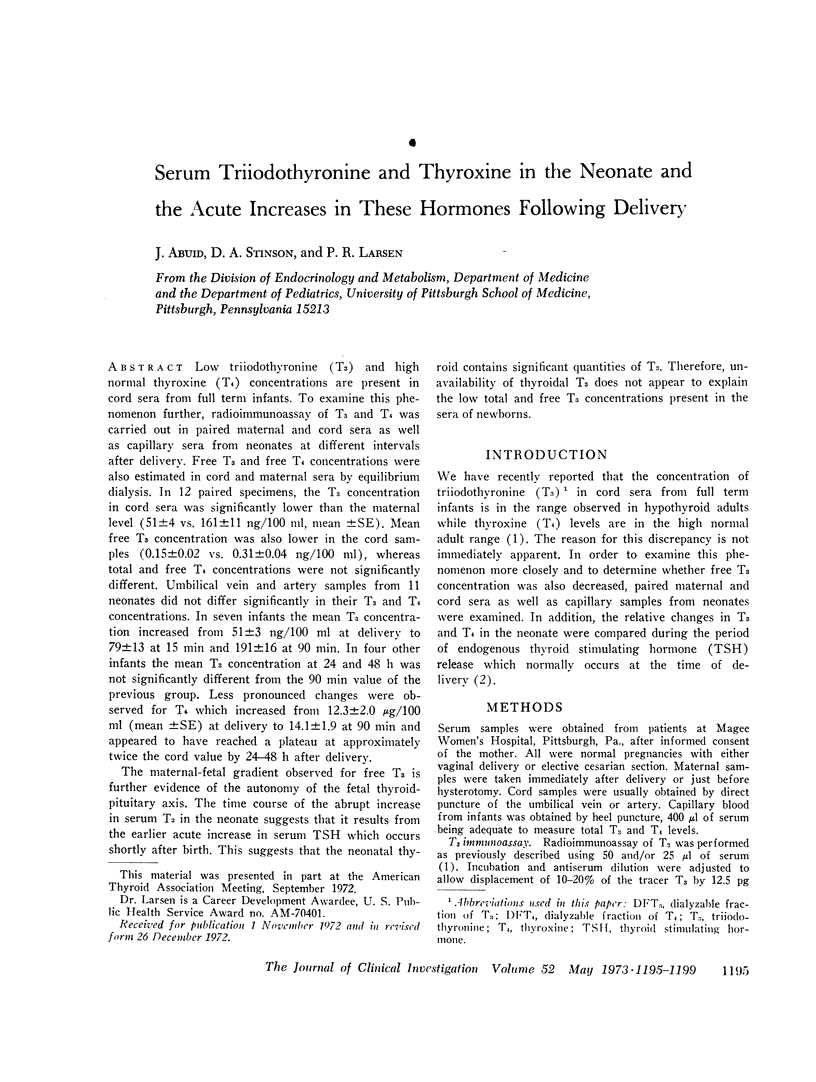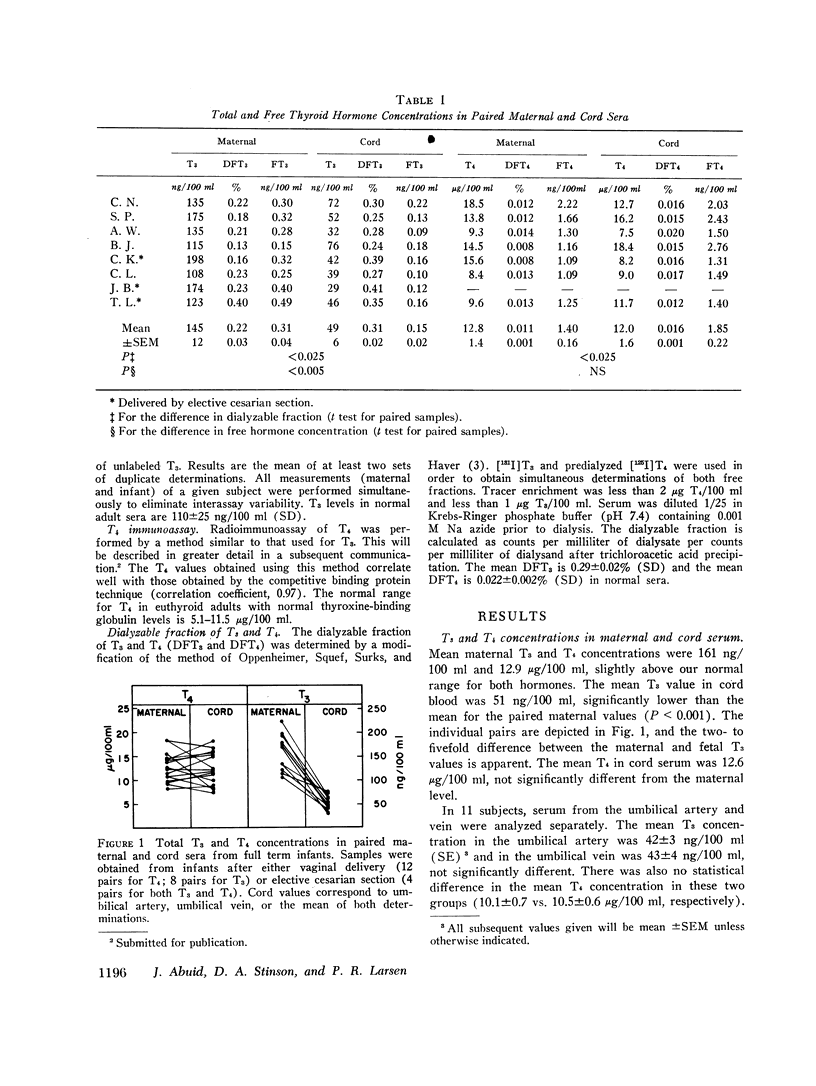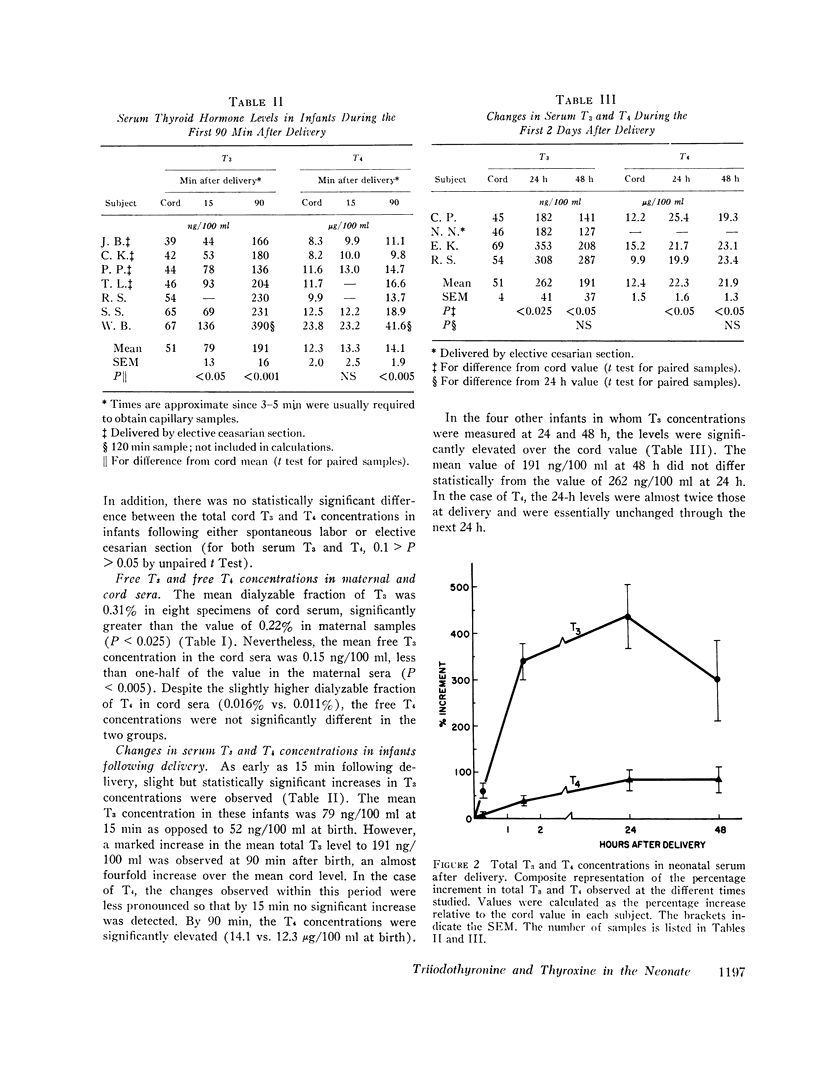Abstract
Low triiodothyronine (T3) and high normal thyroxine (T4) concentrations are present in cord sera from full term infants. To examine this phenomenon further, radioimmunoassay of T3 and T4 was carried out in paired maternal and cord sera as well as capillary sera from neonates at different intervals after delivery. Free T3 and free T4 concentrations were also estiamted in cord and maternal sera by equilibrium dialysis. In 12 paired specimens, the T3 concentration in cord sera was significantly lower than the maternal level (51±4 vs. 161±11 ng/100 ml, mean ±SE). Mean free T3 concentration was also lower in the cord samples (0.15±0.02 vs. 0.31±0.04 ng/100 ml). whereas total and free T4 concentrations were not significantly different. Umbilical vein and artery samples from 11 neonates did not differ significantly in their T3 and T4 concentrations. In seven infants the mean T3 concentration increased from 51±3 ng/100 ml at delivery to 79±13 at 15 min and 191±16 at 90 min. In four other infants the mean T3 concentration at 24 and 48 h was not significantly different from the 90 min value of the previous group. Less pronounced changes were observed for T4 which increased from 12.3±2.0 μg/100 ml (mean ±SE) at delivery to 14.1±1.9 at 90 min and appeared to have reached a plateau at approximately twice the cord value by 24-48 h after delivery.
The maternal-fetal gradient observed for free T3 is further evidence of the autonomy of the fetal thyroidpituitary axis. The time course of the abrupt increase in serum T3 in the neonate suggests that it results from the earlier acute increase in serum TSH which occurs shortly after birth. This suggests that the neonatal thyroid contains significant quantities of T3. Therefore, unavailability of thyroidal T3 does not appear to explain the low total and free T3 concentrations present in the sera of newborns.
Full text
PDF




Selected References
These references are in PubMed. This may not be the complete list of references from this article.
- Dussault J., Row V. V., Lickrish G., Volpé R. Studies of serum triiodothyronine concentration in maternal and cord blood: transfer of triiodothyronine across the human placenta. J Clin Endocrinol Metab. 1969 Apr;29(4):595–603. doi: 10.1210/jcem-29-4-595. [DOI] [PubMed] [Google Scholar]
- Fisher D. A., Dussault J. H. Contribution of methodological artifacts to the measurement of T3 concentration in serum. J Clin Endocrinol Metab. 1971 May;32(5):675–679. doi: 10.1210/jcem-32-5-675. [DOI] [PubMed] [Google Scholar]
- Fisher D. A., Hobel C. J., Garza R., Pierce C. A. Thyroid function in the preterm fetus. Pediatrics. 1970 Aug;46(2):208–216. [PubMed] [Google Scholar]
- Fisher D. A., Odell W. D. Acute release of thyrotropin in the newborn. J Clin Invest. 1969 Sep;48(9):1670–1677. doi: 10.1172/JCI106132. [DOI] [PMC free article] [PubMed] [Google Scholar]
- Greenberg A. H., Czernichow P., Reba R. C., Tyson J., Blizzard R. M. Observations on the maturation of thyroid function in early fetal life. J Clin Invest. 1970 Oct;49(10):1790–1803. doi: 10.1172/JCI106397. [DOI] [PMC free article] [PubMed] [Google Scholar]
- Hotelling D. R., Sherwood L. M. The effects of pregnancy on circulating triiodothyronine. J Clin Endocrinol Metab. 1971 Nov;33(5):783–786. doi: 10.1210/jcem-33-5-783. [DOI] [PubMed] [Google Scholar]
- Larsen P. R. Direct immunoassay of triiodothyronine in human serum. J Clin Invest. 1972 Aug;51(8):1939–1949. doi: 10.1172/JCI107000. [DOI] [PMC free article] [PubMed] [Google Scholar]
- Larsen P. R. Triiodothyronine: review of recent studies of its physiology and pathophysiology in man. Metabolism. 1972 Nov;21(11):1073–1092. doi: 10.1016/0026-0495(72)90038-8. [DOI] [PubMed] [Google Scholar]
- OPPENHEIMER J. H., SQUEF R., SURKS M. I., HAUER H. BINDING OF THYROXINE BY SERUM PROTEINS EVALUATED BY EQUILIBRUM DIALYSIS AND ELECTROPHORETIC TECHNIQUES. ALTERATIONS IN NONTHYROIDAL ILLNESS. J Clin Invest. 1963 Nov;42:1769–1782. doi: 10.1172/JCI104862. [DOI] [PMC free article] [PubMed] [Google Scholar]
- Pittman C. S., Chambers J. B., Jr, Read V. H. The extrathyroidal conversion rate of thyroxine to triiodothyronine in normal man. J Clin Invest. 1971 Jun;50(6):1187–1196. doi: 10.1172/JCI106596. [DOI] [PMC free article] [PubMed] [Google Scholar]
- Raiti S., Holzman G. B., Scott R. L., Blizzard R. M. Evidence for the placental transfer of tri-iodothyronine in human beings. N Engl J Med. 1967 Aug 31;277(9):456–459. doi: 10.1056/NEJM196708312770903. [DOI] [PubMed] [Google Scholar]


